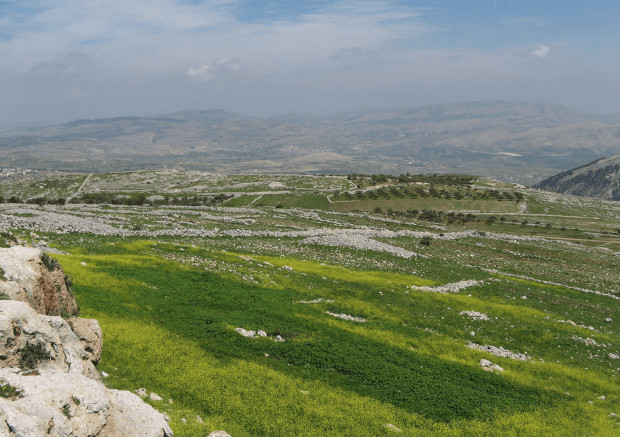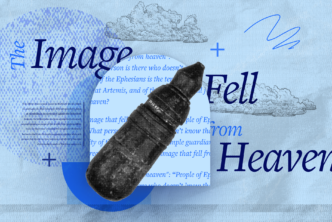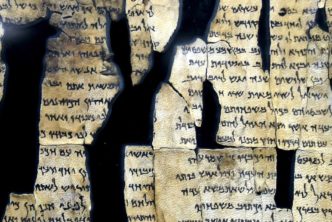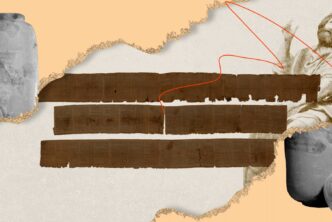Mount Gerizim, Schechem, Mount Ebal in Israel
Toward the end of Deuteronomy, Moses tells the Israelites that, after they cross the Jordan River into the land of Canaan, one of the first things they are to do is build an altar on Mount Ebal and renew their covenant with the LORD (Deut 27:1–8). The book of Joshua reports the fulfillment of that command: Joshua leads the Israelites to Mount Ebal where they build the altar and offer burnt offerings and peace offerings upon it (Josh 8:30–35).
By the nineteenth century, the altar on Mount Ebal had acquired something of legendary status. Between 1865 and 1922, a number of scholars devoted considerable efforts to find it. However, they all confined their search to the high southern slope of Mount Ebal and found nothing. After these failed attempts, no one returned to Mount Ebal in Israel to look for the altar.
A fresh exploration
In 1978, Israeli archaeologist Adam Zertal launched a survey of the entire territory allotted to the Israelite tribe of Manasseh. In 1980, during the early days of the survey, he and his team found a massive mound of stones on the northern slopes of Mount Ebal in Israel. They excavated the site over eight seasons, from 1982 to 1989, and found it had two phases.
In Stratum II (the lower stratrum representing the earlier phase), the site consisted of a structure of some kind with a six-foot-wide depression full of ash and charred animal bones near its center. A chalice was found nearby. The four-room house was paved over in this period to make a courtyard in front of the main complex. A thin wall subdivides the space in front of the structure from that beyond it, and another thin wall, about 3 feet high and 820 feet long, surrounds the entire site.
Zertal interpreted both phases as cultic in nature, with the main structure of Stratum IB thought to be an altar on which ritual sacrifices took place. In a 1985 article, Zertal suggests that the main structure may be associated with the altar of Joshua 8:30–35 and that it may have served as a central sanctuary among the early Israelites.1
Skeptics dismissed the structure as a watchtower, a house, or a barbecue site. However, the main structure of Stratum IB conforms to most of the biblical principles of Israelite altar architecture. Basically, it appears to be a stone adaptation of the wooden altar described in Exodus 27:1–7.
Mount Ebal altar from the north
In addition, the pottery remains, including the limited repertoire and the specialized function of many of the vessels, support identifying the site as an Israelite cultic site. Furthermore, the kinds of animal remains, the number and distribution of burnt bones, and the high proportion of foreparts2 all point to the site’s function as a sacrificial altar for an Israelite community. These and other findings indicate that the Ebal site very likely lay behind the traditions reflected in Joshua 8:30–35.3
Evidence that speaks
When I was working on my doctoral dissertation about the Ebal site, I spent a week with Zertal. One morning while we were driving to the site, he told me his critics had accused him of trying to prove the Bible. They said he imposed a cultic interpretation onto the stone structure he had found. He explained, though, that he had been born and raised in Ein Shemer, Israeli kibbutz that was affiliated with a secular movement. He said he had grown up believing that the Bible was full of myths. When he did his graduate work in archaeology, he did it at Tel Aviv, the most liberal university in Israel, where those views were reinforced.
He insisted he had not embarked on his excavation at Mount Ebal in order to prove the Bible. What he found there, however, had a profound effect on him. He said, “I became a believer at Mount Ebal.”

The evidence he found had changed his view of the Bible. He had grown up thinking it was full of myths and legends, but Mount Ebal convinced him it was full of history.
The site on Mount Ebal in Israel changed me, too. I’ll never forget the first time I saw it.
It was the morning of Sunday, March 11, 2007. I had been studying the Ebal site for years but, as Zertal and I walked along the heavily rutted dirt road on the second slope on the northern side of the mountain, the actual site suddenly came into view. The description in Joshua 8:30–35 suddenly came to life for me, and I would never be the same.
I knew then that Joshua’s altar was not a myth, but reality.
***
To learn more about the geography and archaeology of Israel, we recommend Lexham Geographic Commentaries (5 vols.) and Archaeology in Action: Biblical Archaeology in the Field (3 hour course).
This article originally appeared in the March/April 2019 edition of Bible Study Magazine.
Ralph K. Hawkins is professor of religion at Averett University in Danville, Virginia. He is the author of How Israel Became a People (Abingdon, 2013) and Joshua in the Evangelical Exegetical Commentary series (Lexham Press, forthcoming). He is codirector of the excavation at Khirbet Auja el-Foqa (www.jvep.org).
- Adam Zertal, “Has Joshua’s Altar Been Found on Mt. Ebal?” in BAR 1 (Jan/Feb: 1985), 26–43.
- For the importance of the high numbers of foreparts among the animal remains at Ebal, see Exod 29:22 and Lev 7:28–36.
- For a full discussion of the archaeology of the Ebal site and its interpretation, see Ralph K. Hawkins, Iron Age I Structure on Mt. Ebal: Excavation and Interpretation (Winona Lake, IN: Eisenbrauns), 2012.




